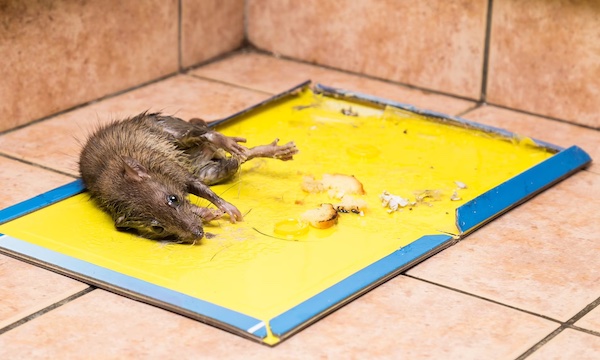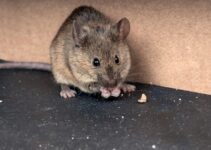Glue traps do not kill stuck mice or rodents straightaway. Instead, the adhesive on the board holds on to animals and subjects them to dehydration, exhaustion, and suffocation before they die.
For this reason, they are considered illegal in some countries.

Are Glue Traps Illegal?
Yes, due to their cruel nature of rodent control, glue traps are considered illegal in countries like Ireland, Norway, Iceland, and Germany, to name a few.
Beyond their cruel form of operation, glue traps problems include:
1. Risk to Human Health
Glue traps are not designed to be reused. This is wrong as it puts you and your household at risk of getting infected by germs.
Mice can also bite you if you do not know how to release them properly. In an attempt to break free, mice often defecate, bleed, urinate or tear a part of their body. These remnants must be properly dumped to keep everyone safe.
2. Glue Traps are Indiscriminate
Glue traps do not discriminate, they hold on to whoever or whatever comes in contact with them. If you have pets such as cats and dogs, you should restrict their movements to avoid getting stuck.
Glue Trap Alternatives: Humane Ways To Capture or Kill Mice
1. Electric Mouse Traps
Electric mouse traps are designed to kill mice via high volts. The trap has two metal plates that mice must step on to reach the bait. Once they step on these plates, they get zapped with high voltage, leading to instant and painless death.
For better effectiveness, you may place a wet rag or towel just in front of the trap. The mouse’s feet will get wet and experience an accelerated death.
Electric traps may not be cheap but they are very effective. The trap displays a green light after every kill. They must also be carefully cleaned before reuse and switched off when not in use.
2. Cube Traps
Cube or box traps are live trap models designed to capture mice alive. The trap doors are designed to shut once a mouse enters to eat the bait. They are always ventilated and will keep the mouse alive as long as you want.
We always recommend releasing captured mice into the wild, especially close to where they were found. However, you can choose to kill them humanely or release them to pest control agencies
3. Bucket Traps
Bucket traps also capture mice alive. Just like cube traps, they can capture as many mice as possible within a short period. However, you need strong baits like peanut butter or fruit jam to achieve this.
The setup includes placing the bait at the edge of a plank such that when a mouse gets close to the bait, the plank collapses and the mouse drops into the bucket. Bucket traps are considered humane if the bucket is not filled with water.
How to Make Your Home Free of Rats
1. Eliminate Food Sources
Rodents will always nest in homes with enough food sources. Beyond using traps, you can starve them to evict them. All you need is to:
- Ensure your home and its environs (especially the kitchen) are free of food remnants.
- Keep pet food insecure (chew-proof) containers
- Trim the grasses in your surrounding and garden regularly. Fallen fruits and vegetables must be picked before mice locate them.
2. Use Repellents or Sonic Emitters on Active Sites
Placing repellents in entry points like cracks and holes can help with mice eviction. Ammonia-soaked towels, cotton balls, or peppermint oil are strong mice repellents.
Sonic emitters are also great rodent repellents. They emit waves that are disruptive to mice and keep them out of your home. Owners of pets like dogs or cats are advised against this device because it may affect them.
3. Seal Entry Points
Entry points for mice are majorly openings like cracks, holes in doors or windows, and gaps in the roof. You may seal these openings before hunting for mice if you are using traps. For homeowners using repellents, they are best sealed after mice have been fully repelled.
Conclusion
In countries where glue traps are illegal, you are not allowed to use, sell or buy these traps. The penalties involved (which may vary depending on the country) usually include:
- 240 penalty units or imprisonment for 2 years (for natural persons).
- 1200 penalty units for corporate bodies.
Note: a penalty unit is valued at $181.74 (more or less) depending on the country.
References
- https://agriculture.vic.gov.au/livestock-and-animals/animal-welfare-victoria/pocta-act-1986/humane-vertebrate-pest-control/glue-traps
- https://www.hsi.org/news-media/inhumane-rodent-glue-traps-to-be-banned-in-england/
- https://www.peta.org/action/steps-to-rescue-animals-from-glue-traps/
- https://www.humanesociety.org/resources/glue-boards
- https://www.mspca.org/animal_protection/glue-traps/





